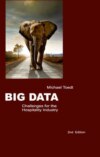Основной контент книги Big Data - Challenges for the Hospitality Industry
Text
Volume 34 pages
$11.70
About the book
Hotel companies who are able to deal with Big Data will create a sustainable competitive advantage. But what is Big Data and how can we use it in the Hospitality Industry? What is the distinctive value and what are key areas for a successful implementation? Michael Toedt explains in this book the biggest hurdle – the lack of knowledge within the senior management and the willingness to implement the necessary changes – and gives hoteliers recommendations to avoid the main failures.
Genres and tags
Log in, to rate the book and leave a review
Book «Big Data - Challenges for the Hospitality Industry» — read a free excerpt of the book online. Leave comments and reviews, vote for your favorites.












